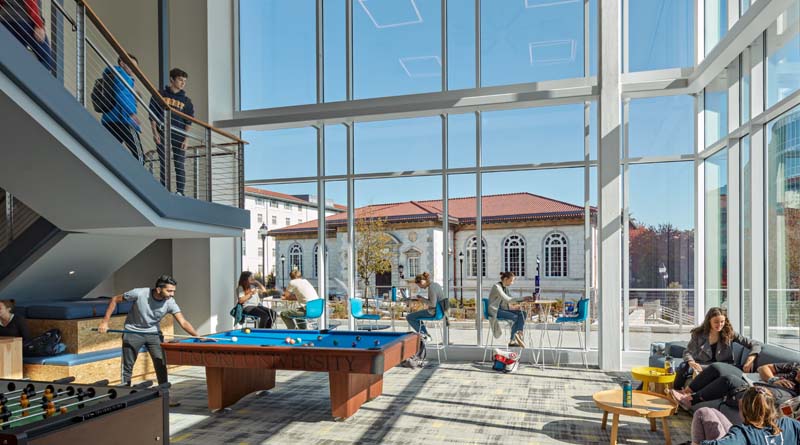By Turan Duda and Jeffrey Paine
Universities are in the throes of determining how students might safely return to campus. We at Duda|Paine, and many of our peers, are exploring ways that design can help define a ‘new normal.’ Much about this particular virus’s evolution remains unknown, and architects and designers are ‘learning as we go’ in strategizing a return to some semblance of “normal.” Experts, including medical professionals, epidemiologists and researches, will ultimately be critical partners in establishing criteria for design in a post-COVID-19 world.
About More Than Education
Human beings are inherently social. We gain important cues from physical dynamics, expressive gestures and body language not apparent virtually. Productivity may increase with remote work, but creativity and innovative thinking thrive when we are all in the same room. Learning also benefits from this in-person dynamic, and campus life provides much more than academic education—it offers a place for personal development and social maturation many young people wouldn’t gain otherwise.
Adapting Learning Models
Robust distance learning programs have been essential for institutions and students to weather this unusual time. Blended learning—using virtual and classroom systems in the same curriculum—and a phased plan to control density are starting points, but protocol must be established for ongoing reassessment and reconfiguration as health science related to the virus progresses.
For the time being, the density of existing learning and student life spaces must be reduced—a 200-person auditorium might only accommodate fifty students in the fall. Alternatively, large lectures may become entirely virtual with smaller seminars taught in person. Universities will need to define which learning activities are ‘essential’ to be conducted in person, and those well suited to virtual forums. Classroom models will be reconfigured for appropriate distancing practices, perhaps with the class splitting into alternating weeks of virtual and classroom sessions to establish manageable class sizes.
Team meeting and collaboration spaces—‘must haves’ only months ago—today appear threatened by concern for virus containment. Designers are already investigating solutions to prevent these innovation-fueling spaces from being eliminated from campus and office environments. Moveable furniture and individual study spaces can accommodate distancing while allowing students to be together while working alone.
Developing Design Options
We have a rich palette of existing and new innovations in design to put in place for safer campus spaces and buildings as both temporary and permanent measures. The main “living room” spaces at NC State’s Talley Student Union and Emory University’s Student Center include mobile and flexible furnishings. Movable partitions and panel systems could be added to allow more distancing-appropriate configurations that can evolve as needs change. Serveries and other aspects of dining and food service will evolve as well with sneeze guards and more robust sanitizing protocols.
We’ve long advocated for all projects to include multiple outdoor spaces such as terraces, plazas and gardens. Talley Student Union’s Stafford Commons and the Emory Student Center Outdoor Plaza provide open air space to the campus community. Emory Student Center’s large building program was divided into smaller pavilions unified under a shade trellis. Given Atlanta’s temperate climate, building spaces—including terraces, generous exterior circulation and a grand connecting stair—were placed outdoors to reduce heating and cooling needs. Today, this variety of open-air spaces, complete with moveable seating and tables, presents options for meeting in fresh air. Once considered alternative lounge spaces for student centers, these areas may now become health-conscious standards for classroom buildings and auditoriums.
Campus-wide controls such as wayfinding, signage and landscaping, which are part of any campus safety system, can aid in controlling the flow of pedestrian traffic, especially in combination with temporary pavement markings. Coupling these with contactless building and room entries, the use of facial recognition software over keypads, and more hands-free equipment in common areas such as touchless elevators, with lower passenger allowances, make sense today.
Upgraded and reconfigured air filtration systems can alter the direction of airflow downward, reducing the impact of airborne diseases. Inherently antimicrobial finishes and surfaces can be supplemented by accelerated and more robust cleaning protocols by users and cleaning teams.
Adapting Student Wellness Centers
Wellness programs—already becoming a proactive force on many campuses—will increase in importance. We see instruction in hygiene being added to wellness training programs, much like nutrition education and teaching kitchens are integrated into today’s wellness facilities. Student health and wellness centers will likely require new and additional spaces for isolation and quarantine, as will dorms.
Spaces that facilitate healthy choices may also contribute to every individual’s capacity to care for themselves, including oasis and meditation spaces. Waiting rooms may get larger, with more zones of separation, so those seeking routine care can have separation from those who are sick. These functional additions can accelerate our focus on wellness and encourage attention to self-care.
The Macro Culture
Density and efficiency have long been standards for controlling costs in new construction. With all we’ve learned in the first half of 2020, we may see changes in cost tolerances for new construction such as wider, more generous hallways and larger minimum floor area around desks. More generous spaces in public rooms and corridors would allow everyday distancing. And, a return to operable windows can provide ventilation and access to fresh air.
COVID-19 will reframe much of how we operate as a culture, society and economy. Changes related to building design will eventually become part of our architectural lexicon, much like behaviors and laws evolved around automobile seat belts and smoking. In addition to being social creatures, we are also infinitely adaptable. Returning to work, school and social engagement can be done thoughtfully, safely and with health and long-term wellness in mind.
Turan Duda, FAIA, & Jeffrey Paine, FAIA, are founding principals with Duda|Paine Architects, launched in 1997.


